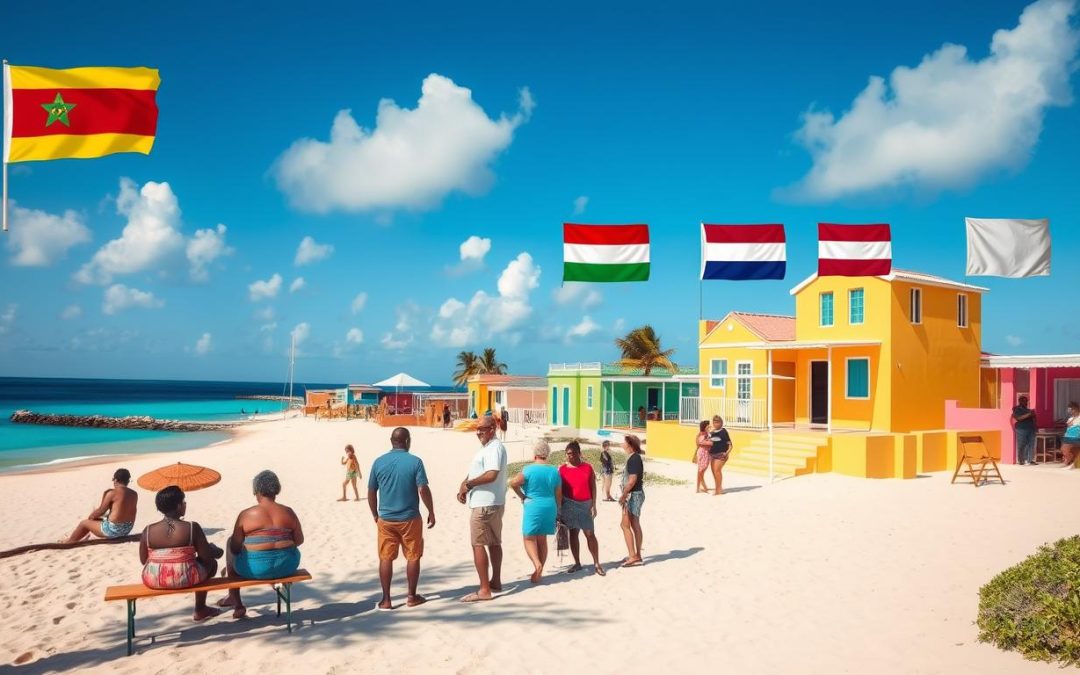Have you ever wondered how a small Caribbean island can communicate across multiple linguistic landscapes? Bonaire offers a fascinating linguistic journey that challenges traditional language expectations.
Nestled in the Caribbean, Bonaire is a unique linguistic melting pot. It has multiple languages living together in harmony. As a special municipality of the Netherlands, Dutch is the official language. But, Papiamento is the heart of everyday talk, spoken by about 85% of the people.
The island’s language diversity goes beyond Dutch and Papiamento. English and Spanish are also widely spoken. This shows the multicultural heritage and international ties that shape Bonaire’s way of communicating.
Key Takeaways
- Dutch is the official administrative language of Bonaire
- Papiamento serves as the primary spoken language among locals
- English and Spanish contribute to the island’s multilingual environment
- 85% of Bonaire’s population speaks Papiamentu as their first language
- The linguistic diversity reflects the island’s rich cultural history
Understanding Bonaire’s Linguistic Landscape
Bonaire’s story is one of cultural mix and change over time. With only 25,133 people living on 288 km², it’s a small but diverse place. It shows how languages can bring people together.
The island’s language mix comes from its history. Spanish and Dutch colonizers, African slaves, and indigenous Caquetío people all left their mark. This mix created a unique way of speaking.
Historical Language Development
Bonaire’s language has grown from its rich culture. Important moments include:
- Spanish colonial period introducing European linguistic elements
- Dutch administrative influence starting in the 17th century
- African language contributions through enslaved populations
- Indigenous Caquetío language foundations
Current Language Distribution
Today, Bonaire is a lively place where many languages are spoken:
- Papiamento: Primary communicative language
- Dutch: Official administrative language
- Spanish: Widely understood
- English: Prominent in tourism
Cultural Significance
Languages are the roadmaps of a culture. They tell you where its people come from and where they are going.
The languages of Bonaire are more than just words. They show the island’s strong culture. Each language holds memories of the past, showing how people have changed and grown together.
About 80% of the people are Dutch nationals, and nearly 60% were born in the former Netherlands Antilles. Bonaire’s language scene is always changing, celebrating its diverse heritage.
Dutch as the Official Administrative Language
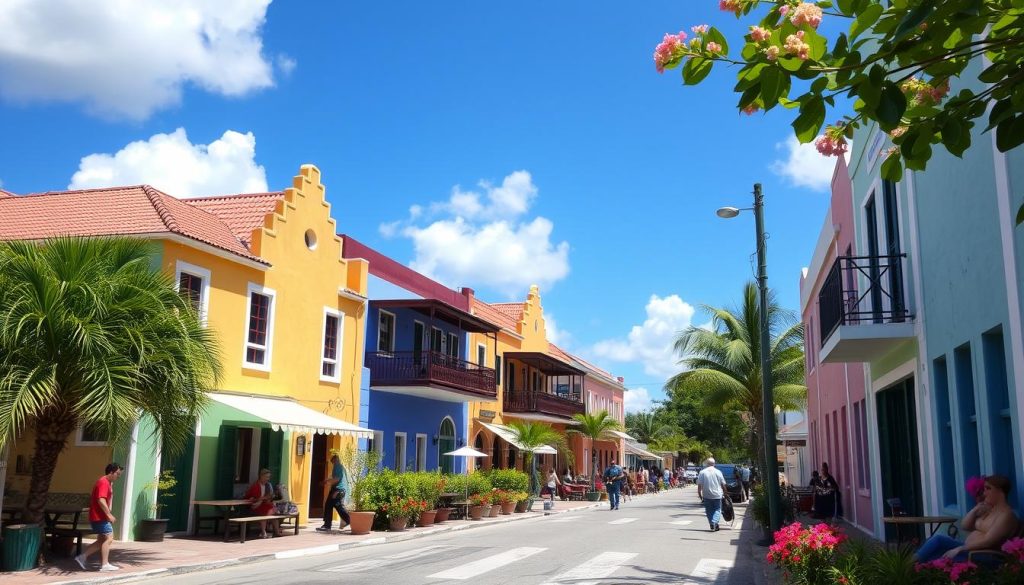
In Bonaire, the Dutch language is key in government. Even though only 15% of people speak it, Dutch is used for laws, government, and schools. This shows its importance in the island’s life.
Dutch’s role in Bonaire is tied to its history. As part of the Netherlands Kingdom, Dutch is the official language. This makes Bonaire’s language scene unique.
“Language is the roadmap of a culture. It tells you where its people come from and where they are going.” – Rita Mae Brown
Here are some key points about Dutch in Bonaire’s government:
- Government documents and legal actions are in Dutch.
- Schools teach mainly in Dutch.
- You need to know Dutch for official talks.
Using Dutch in Bonaire is not without its challenges. Papiamento is the most common language, but Dutch holds a special place in official matters.
| Language Domain | Dutch Usage |
|---|---|
| Government | Primary Official Language |
| Legal System | Exclusive Language |
| Education | Instructional Medium |
| Daily Communication | Limited Usage |
Learning about Bonaire’s languages shows a mix of official needs and daily talks. It’s a complex mix.
Papiamento: The Heart of Bonaire’s Communication
Dive into the vibrant world of Papiamento, the heart of Bonaire’s culture. This unique creole language brings together many historical influences. It connects the island’s diverse cultural roots in every conversation.
Origins and Linguistic Roots
Papiamento is a powerful creole language. It combines elements from many languages. Its origins come from a mix of:
- Portuguese maritime influences
- Spanish colonial heritage
- Dutch administrative language
- African linguistic contributions
- English trading interactions
Common Phrases and Cultural Expression
Learning Papiamento opens a window to Bonaire’s soul. Some popular phrases include:
- Bon bini – Welcome
- Danki – Thank you
- Kon ta – How are you?
“Papiamento is not just a language, it’s the living breath of Bonaire’s cultural identity.”
Language Demographics and Impact
| Language Statistic | Percentage |
|---|---|
| Papiamento Speakers | 74.7% |
| Primary Communication Language | Approximately 2/3 of Population |
The Papiamento language is more than just a way to talk. It shows resilience, cultural preservation, and Bonaire’s unique identity. Whether in music, literature, or everyday talk, this creole language keeps evolving. It reflects the island’s lively spirit.
Spanish Influence and Usage
Bonaire’s language scene is interesting, with Spanish being a big part. It’s a minority language but deeply affects how people talk. Spanish is important for Bonaire’s history and today.
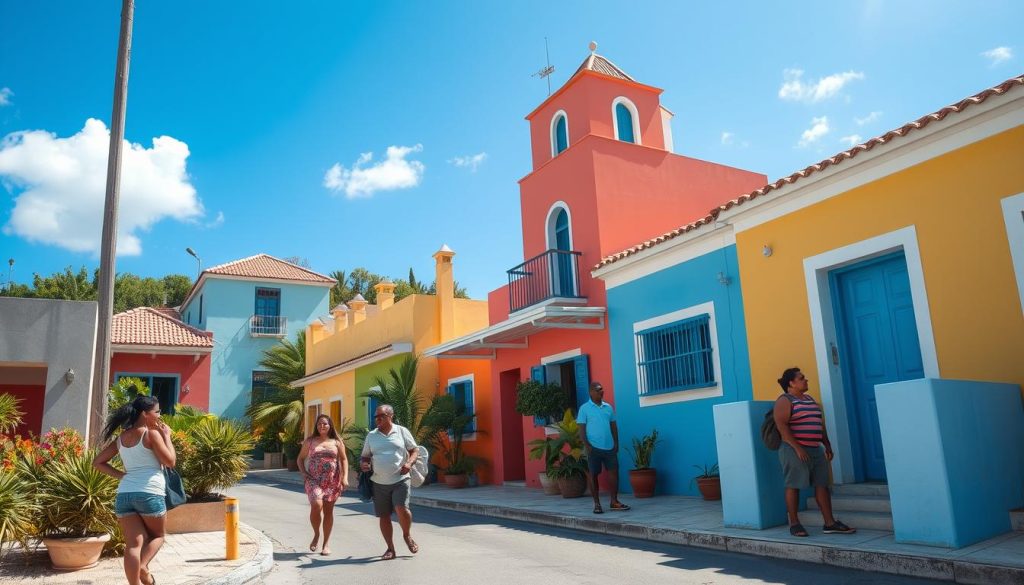
- Nearly 11.8% of Bonaire’s population speaks Spanish as their primary language
- Being close to South America makes Spanish more influential
- Spanish helps connect with nearby areas
Spanish’s impact comes from Bonaire’s past and ties with Spanish-speaking countries. You’ll see Spanish in everyday talks, business, and culture.
“Language is the roadmap of a culture. It tells you where its people come from and where they are going.” – Rita Mae Brown
Even though Dutch is the official language, Spanish is still alive. People use Spanish for work, socializing, and staying in touch with South America. Knowing some Spanish can make your visit to Bonaire better.
Bonaire’s mix of cultures means Spanish is key to its language history. It’s one of the minority languages that make Bonaire’s way of speaking unique.
English Language Role in Tourism and Business
Bonaire’s language scene is a big plus for visitors and business folks. English acts as a key link, connecting the island’s varied cultures with the world.
On Bonaire, English is key in many areas. The island’s focus on speaking many languages makes it easy for tourists and business people to get along.
Tourism Communication Strategies
In tourism, English is crucial for great visitor experiences. Hotel staff use English to:
- Share detailed info about the island
- Give personalized service
- Help with international guest needs
- Support diving, marine, and eco-tours
Business Application Insights
For business, English is essential in Bonaire. International companies like the island’s language skills for:
- Easy business talks
- Good teamwork across cultures
- Opportunities for growth
- Connecting with the world market
International Relations Dynamics
English is key for Bonaire’s global ties. It helps with diplomacy and business on the world stage.
| Language Proficiency | Business Impact | Tourism Effectiveness |
|---|---|---|
| High English Comprehension | Enhanced Global Connections | Excellent Guest Experience |
| Multilingual Workforce | Competitive Economic Advantage | Diverse Communication Channels |
“English is the gateway to global opportunities in Bonaire’s dynamic business and tourism landscape.”
By focusing on English, Bonaire becomes a top spot for international business and tourism. It connects cultures through language.
Language Education System in Bonaire
Bonaire’s language education system shows off its rich cultural background. It starts with a special way of learning languages. The focus is on mastering many languages well.
Students in Bonaire face a complex language world. It gets them ready for talking to people everywhere. The school plan includes:
- Dutch as the main teaching language
- Papiamento used every day
- English for global chances
- Deep programs in many languages
The way schools teach languages in Bonaire is amazing. A survey of 262 questionnaires showed how much the island values language learning. Kids usually speak many languages by the end of primary school.
“Language is the roadmap of a culture. It tells you where its people come from and where they are going.” – Rita Mae Brown
But, keeping language diversity alive is tough. Since 2010, political changes have made it harder to save Papiamentu. Still, the community keeps working hard for multilingual education.
| Language | Educational Status | Usage Level |
|---|---|---|
| Dutch | Primary Instruction Language | High |
| Papiamentu | Cultural Language | Moderate |
| English | International Communication | Growing |
Learning about Bonaire’s language education shows a flexible, forward-thinking approach. It gets students ready for the world.
Bonaire: Official and Widely Spoken Languages
Diving into Bonaire’s language scene shows a colorful mix of communication. This mix reflects the island’s unique cultural heritage. Language stats and demographic data paint a vibrant picture of linguistic diversity in this Caribbean gem.
The island has 25,133 residents, showing a complex linguistic environment. Here, many languages live together in harmony. Knowing the language demographics helps us understand Bonaire’s social fabric.
Language Usage Breakdown
- Papiamento: Spoken by approximately 74.7% of the population
- Dutch: Primary language for 15% of residents
- Spanish: Used by 11.8% of inhabitants
- English: Common in tourism and business
Population Linguistic Characteristics
The demographic data offers interesting insights into Bonaire’s language scene. Most people are multilingual, speaking at least two languages well. About 80% of the people are Dutch nationals, with nearly 60% born in the former Netherlands Antilles and Aruba.
“Language is the road map of a culture. It tells you where its people come from and where they are going.” – Rita Mae Brown
The island’s population density of 83.6 residents per square kilometer makes language interactions frequent and lively. This close community helps keep and grow the island’s language diversity.
Cultural Linguistic Significance
In Bonaire, language is more than just a way to communicate. It’s a living part of cultural identity. The mix of Papiamento, Dutch, Spanish, and English shows the island’s rich history and ongoing cultural exchanges.
Multilingual Media and Publications
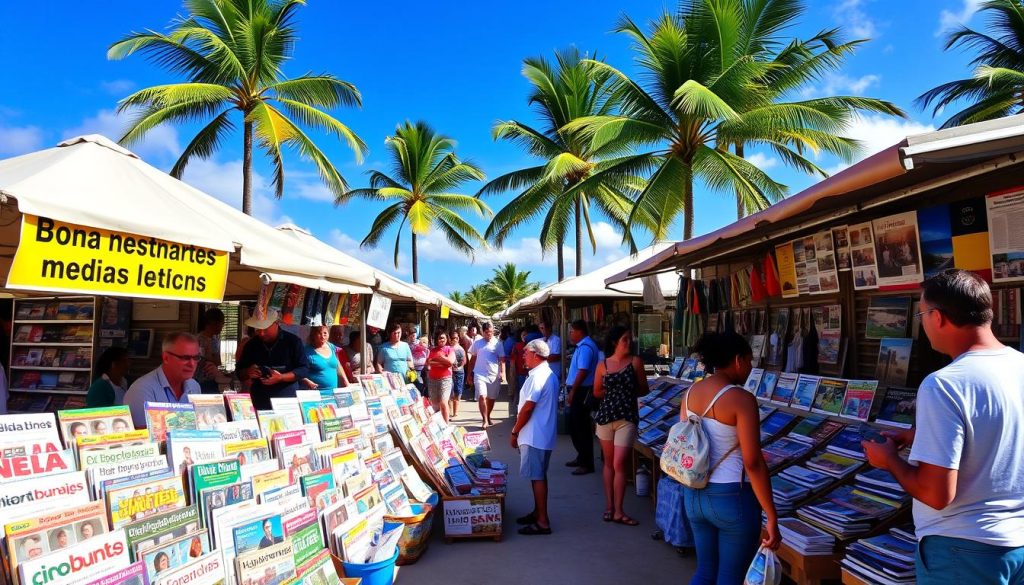
Bonaire’s vibrant linguistic landscape shines through its diverse media. Your journey through the island’s communication channels shows a rich tapestry of local publications. These reflect the community’s linguistic diversity.
Local media in Bonaire covers many languages, serving the island’s multicultural population. Key publications include:
- The Bonaire Reporter – An English-language newspaper
- Local Dutch-language newspapers
- Papiamento publications
- Online news platforms like Bonaire Insider
Language preservation is key in these media outlets. They are not just information sources but also cultural bridges. Radio stations and digital platforms help by broadcasting in multiple languages.
“Media is the heartbeat of linguistic diversity in Bonaire” – Local Communication Expert
These multilingual media channels let residents and visitors get information in their preferred language. This supports communication and cultural understanding across diverse linguistic groups.
The media landscape shows Bonaire’s commitment to its rich linguistic heritage. It also shows its openness to global communication trends.
Language Preservation Efforts
Bonaire is dedicated to keeping its language alive. This shows its deep cultural roots. The island works hard to protect and celebrate its languages, especially Papiamento.
Government Linguistic Initiatives
The Bonairean government has set up important plans to save languages:
- Developing standardized spelling systems for Papiamento
- Creating comprehensive language training materials
- Supporting educational programs that promote linguistic diversity
- Establishing official documentation in multiple languages
Community Language Programs
Local groups are key in keeping language traditions alive. They run:
- Cultural events celebrating linguistic heritage
- Free community language classes
- Artistic projects highlighting Papiamento’s unique characteristics
“Language is the roadmap of a culture. It tells you where its people come from and where they are going.” – Rita Mae Brown
Learning about these efforts shows how important language is to Bonaire. The island’s mix of languages ensures its culture stays vibrant for the future.
About 70% of Papiamento comes from Portuguese and Spanish. These efforts keep the language special while honoring its varied history.
Cultural Identity Through Language
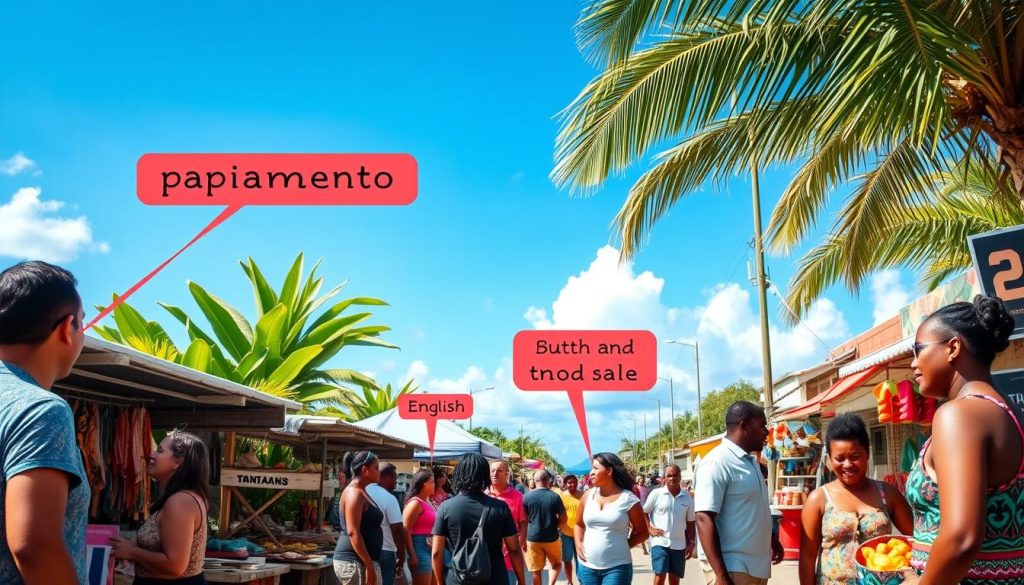
Language is at the heart of Bonaire’s culture, creating a rich mix of communication. It shows the island’s diverse heritage. The way people talk in Bonaire is more than just words; it’s the soul of their social life and shared history.
Papiamento is the main way people express their culture. It’s a creole language that shows Bonaire’s mix of cultures. It blends African, European, and indigenous traditions.
“Language is the road map of a culture. It tells you where its people come from and where they are going.” – Rita Mae Brown
- Papiamento keeps historical stories alive
- Local dialects show what different generations have experienced
- Language brings people together across ages
Looking at language in Bonaire gives us interesting views into its culture:
| Language | Percentage of Main Usage |
|---|---|
| Papiamento | 67% |
| Spanish | 11.8% |
| Dutch | 15% |
Language in Bonaire is alive and shows the island’s social life. Every chat, song, and story adds to the rich cultural fabric of this lively Caribbean place.
Conclusion
Your journey into Bonaire’s languages shows a rich mix of communication. This mix reflects the island’s deep cultural roots. With 91% of people speaking more than one language, Bonaire is a standout in the Caribbean for its language diversity.
The island’s languages blend in a special way. Papiamentu is at the core, spoken by 62% of the people. English and Dutch are key in work and government. This mix makes communication on the island more than just words.
Thinking about Bonaire’s languages helps us see language’s true value. It connects us to history, identity, and community. Whether you’re visiting or living here, getting to know Bonaire’s language scene offers a deeper look into its lively culture.
The future of Bonaire’s languages is bright. Young people are learning to speak many languages. This keeps the island’s unique language heritage alive. Your understanding of these language dynamics lets you see into the heart of Bonaire’s social and cultural identity.
The above is subject to change.
Check back often to TRAVEL.COM for the latest travel tips and deals.
Here are some Tours & Sightseeing suggestions that might pique your interests!
